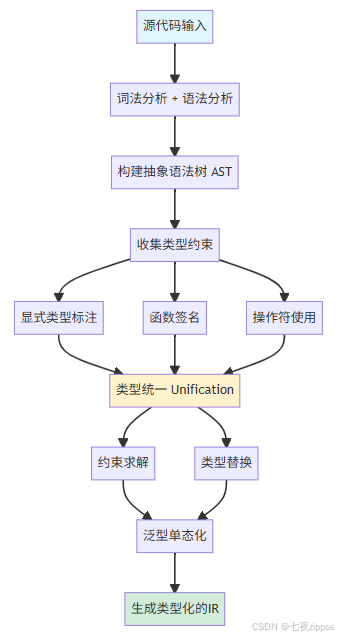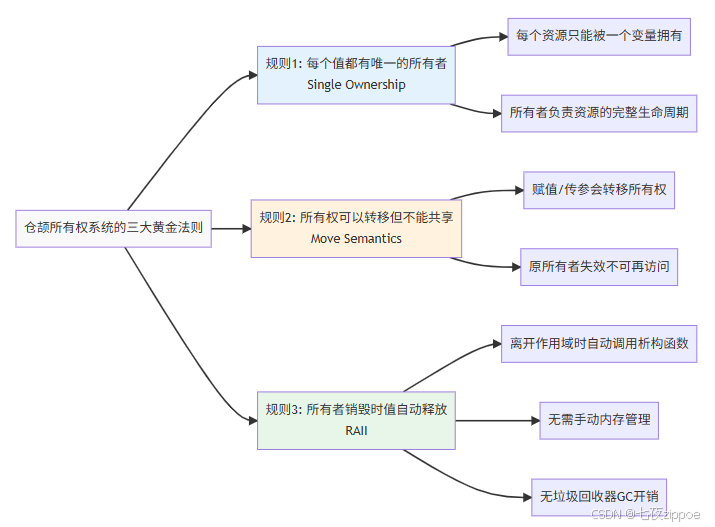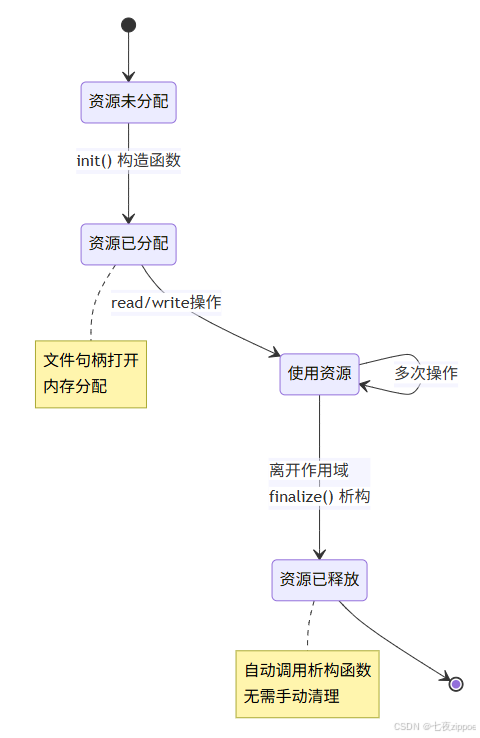目录
[1.1 类型系统的设计哲学](#1.1 类型系统的设计哲学)
[1.2 基本类型体系](#1.2 基本类型体系)
[1.3 类型推导机制](#1.3 类型推导机制)
[1.4 可空类型与Option](#1.4 可空类型与Option)
[2.1 所有权系统的三大规则](#2.1 所有权系统的三大规则)
[2.2 所有权转移(Move Semantics)](#2.2 所有权转移(Move Semantics))
[2.3 借用(Borrowing)机制](#2.3 借用(Borrowing)机制)
[3.1 作用域与生命周期](#3.1 作用域与生命周期)
[3.2 生命周期标注(Lifetime Annotations)](#3.2 生命周期标注(Lifetime Annotations))
[3.3 RAII模式实践](#3.3 RAII模式实践)
[4.1 核心特性对比](#4.1 核心特性对比)
[4.2 关键差异](#4.2 关键差异)
摘要
仓颉语言作为华为自研的系统级编程语言,在类型安全和内存管理方面借鉴了Rust等现代语言的最佳实践。本文深入探讨仓颉的静态类型系统设计、所有权(Ownership)模型实现、生命周期管理机制等核心特性,并与Rust的安全模型进行对比分析。通过详细的代码示例和原理剖析,帮助开发者理解仓颉如何在保证运行时性能的同时实现编译时内存安全保障。
一、静态类型系统深度解析
1.1 类型系统的设计哲学
仓颉采用强静态类型系统 (Strong Static Type System),所有类型在编译时确定,这是构建安全可靠系统的基石。

1.2 基本类型体系
javascript
// ========== 整数类型族 ==========
// 有符号整数
let i8: Int8 = -128 // 8位:-128 ~ 127
let i16: Int16 = -32768 // 16位:-32768 ~ 32767
let i32: Int32 = 100 // 32位(默认整数类型)
let i64: Int64 = 1000000 // 64位
// 无符号整数
let u8: UInt8 = 255 // 8位:0 ~ 255
let u16: UInt16 = 65535 // 16位:0 ~ 65535
let u32: UInt32 = 4294967295 // 32位
let u64: UInt64 = 18446744073709551615 // 64位
// ========== 浮点类型 ==========
let f32: Float32 = 3.14 // 单精度(IEEE 754)
let f64: Float64 = 3.141592653589793 // 双精度(默认)
// ========== 其他基本类型 ==========
let flag: Bool = true // 布尔类型
let char: Char = 'A' // Unicode字符
let str: String = "Hello" // UTF-8字符串
let unit: Unit = () // 单元类型(类似void)
// ========== 类型安全示例 ==========
func demonstrateTypeSafety() {
let x: Int32 = 100
let y: Int64 = 200
// ❌ 编译错误:类型不匹配
// let z = x + y
// ✅ 显式类型转换
let z = (x as Int64) + y
// ❌ 编译错误:不能将浮点赋值给整数
// let a: Int32 = 3.14
// ✅ 正确做法
let a: Int32 = 3.14 as Int32 // 截断为3
}参考链接:
1.3 类型推导机制
仓颉实现了基于Hindley-Milner算法的类型推导系统:
javascript
// ========== 从字面量推导 ==========
let x = 42 // 推导为 Int32
let y = 3.14 // 推导为 Float64
let s = "hello" // 推导为 String
let arr = [1, 2, 3] // 推导为 Array<Int32>
// ========== 从函数返回值推导 ==========
func getAge(): Int32 {
return 25
}
let age = getAge() // 推导为 Int32
// ========== 泛型类型推导 ==========
func identity<T>(value: T): T {
return value
}
let intResult = identity(42) // T 推导为 Int32
let strResult = identity("hello") // T 推导为 String
// ========== 复杂表达式推导 ==========
let computed = if condition { 100 } else { 200 } // Int32
// ========== 闭包类型推导 ==========
let numbers = [1, 2, 3, 4, 5]
let doubled = numbers.map(|x| x * 2) // 推导闭包参数和返回值类型类型推导流程图:

1.4 可空类型与Option
仓颉使用Option类型(代数数据类型ADT)安全地表示可能不存在的值:
javascript
// ========== Option类型定义 ==========
enum Option<T> {
| Some(T) // 包含值
| None // 不包含值
}
// ========== 创建Option值 ==========
func findUser(id: Int32): Option<String> {
if id == 1 {
return Some("Alice")
} else if id == 2 {
return Some("Bob")
} else {
return None
}
}
// ========== 模式匹配处理 ==========
func processUser(id: Int32) {
match findUser(id) {
case Some(name) => {
println("Found user: ${name}")
}
case None => {
println("User not found")
}
}
}
// ========== 语法糖:? 运算符 ==========
let optionalValue: Int32? = Some(42)
let nullValue: String? = None
// if-let 简化模式匹配
if let value = optionalValue {
println("Value: ${value}")
} else {
println("No value")
}
// ========== Option的实用方法 ==========
extension Option<T> {
// 映射操作
func map<U>(f: (T) -> U): Option<U> {
match this {
case Some(value) => Some(f(value))
case None => None
}
}
// 扁平化映射
func flatMap<U>(f: (T) -> Option<U>): Option<U> {
match this {
case Some(value) => f(value)
case None => None
}
}
// 提供默认值
func unwrapOr(default: T): T {
match this {
case Some(value) => value
case None => default
}
}
}与其他语言的对比:
| 语言 | 空值表示 | 安全性 | 说明 |
|---|---|---|---|
| 仓颉 | Option<T> |
✅ 编译时保证 | 强制处理None情况 |
| Rust | Option<T> |
✅ 编译时保证 | 与仓颉类似 |
| Java | null / Optional<T> |
⚠️ 运行时检查 | Optional是库实现 |
| Kotlin | T? |
✅ 编译时保证 | 语言级别支持 |
| C/C++ | NULL / nullptr |
❌ 无保证 | 容易出现段错误 |
二、所有权(Ownership)模型
2.1 所有权系统的三大规则
仓颉的所有权系统是其内存安全的核心机制:

2.2 所有权转移(Move Semantics)
javascript
// ========== 基本的所有权转移 ==========
class Resource {
data: String
public init(value: String) {
this.data = value
println("Resource created: ${value}")
}
public func getData(): String {
return this.data
}
// 析构函数
public func finalize() {
println("Resource destroyed: ${this.data}")
}
}
func demonstrateOwnership() {
// owner1 获得所有权
let owner1 = Resource("data1")
println("Owner1: ${owner1.getData()}")
// 所有权转移给 owner2
let owner2 = owner1
println("Owner2: ${owner2.getData()}")
// ❌ 编译错误:owner1 已失去所有权
// println(owner1.getData())
} // owner2 离开作用域,资源自动释放
// ========== 函数调用的所有权转移 ==========
func takeOwnership(resource: Resource) {
println("Function received: ${resource.getData()}")
// resource 在函数结束时被销毁
}
func testFunctionOwnership() {
let res = Resource("data2")
takeOwnership(res)
// ❌ 编译错误:所有权已转移给函数
// println(res.getData())
}所有权转移流程图:
javascript
sequenceDiagram
participant M as 内存
participant O1 as owner1
participant O2 as owner2
Note over M,O1: let owner1 = Resource("data")
M->>O1: [Resource对象] 所有权 →
Note over O1,O2: let owner2 = owner1
O1->>O2: 所有权转移 →
Note over O1: owner1 失效 ✗
Note over O2,M: } // owner2 离开作用域
O2->>M: 调用 finalize()<br/>释放内存
style O1 fill:#ffcccc
style O2 fill:#ccffcc2.3 借用(Borrowing)机制
javascript
// ========== 不可变借用 ==========
func readData(data: &String) {
// 只能读取,不能修改
println("Reading: ${data}")
}
func testImmutableBorrow() {
let message = "Hello"
readData(&message) // 借用
readData(&message) // 可以多次借用
println(message) // 原所有者仍然有效
}
// ========== 可变借用 ==========
func modifyData(data: &mut String) {
data.append(" World")
}
func testMutableBorrow() {
var message = "Hello"
modifyData(&mut message) // 可变借用
println(message) // 输出:Hello World
}
// ========== 借用规则演示 ==========
func demonstrateBorrowRules() {
var data = "Original"
// ✅ 允许:多个不可变借用
let ref1 = &data
let ref2 = &data
println("${ref1}, ${ref2}")
// ❌ 编译错误:同时存在可变和不可变借用
// let refImmut = &data
// let refMut = &mut data
// ✅ 允许:可变借用后不再有其他借用
{
let refMut = &mut data
refMut.append("!")
} // refMut 的生命周期结束
println(data) // ✅ 可以再次访问
}借用规则总结:

三、生命周期管理
3.1 作用域与生命周期
javascript
// ========== 基本作用域 ==========
func demonstrateScope() {
{
let x = Resource("inner")
println("Inside scope: ${x.getData()}")
} // x 的生命周期结束,自动销毁
// ❌ x 在此处不可访问
}
// ========== 嵌套作用域 ==========
func nestedScopes() {
let outer = Resource("outer")
{
let inner = Resource("inner")
// 可以访问 outer 和 inner
println("${outer.getData()}, ${inner.getData()}")
} // inner 被销毁
// outer 仍然有效
println(outer.getData())
} // outer 被销毁3.2 生命周期标注(Lifetime Annotations)
javascript
// ========== 生命周期参数 ==========
func firstWord<'a>(s: &'a String): &'a String {
let spaceIndex = s.indexOf(' ')
if spaceIndex == -1 {
return s
}
return s.substring(0, spaceIndex)
}
// ========== 结构体中的生命周期 ==========
struct StringSlice<'a> {
data: &'a String
start: Int32
end: Int32
}
impl<'a> StringSlice<'a> {
func new(source: &'a String, start: Int32, end: Int32): StringSlice<'a> {
return StringSlice {
data: source,
start: start,
end: end
}
}
func content(this: &StringSlice<'a>): String {
return this.data.substring(this.start, this.end)
}
}生命周期关系图:

3.3 RAII模式实践
javascript
// ========== 文件资源管理 ==========
class File {
private handle: FileHandle
private path: String
public init(path: String) {
this.path = path
this.handle = openFile(path)
println("File opened: ${path}")
}
public func read(): String {
return readFromFile(this.handle)
}
public func write(data: String) {
writeToFile(this.handle, data)
}
// 析构函数:自动清理资源
public func finalize() {
closeFile(this.handle)
println("File closed: ${this.path}")
}
}
func processFile() {
let file = File("/path/to/file.txt")
file.write("Hello, RAII!")
let content = file.read()
println(content)
} // file 自动关闭,无需手动管理RAII资源管理流程:

四、与Rust安全模型对比
4.1 核心特性对比
| 特性 | 仓颉 | Rust | 说明 |
|---|---|---|---|
| 所有权规则 | 三大规则 | 三大规则 | 核心机制相同 |
| 移动语义 | ✅ 默认移动 | ✅ 默认移动 | 赋值即转移所有权 |
| 借用检查 | ✅ 编译时 | ✅ 编译时 | borrow checker |
| 生命周期标注 | <'a> |
<'a> |
语法相同 |
| 智能指针 | Box/Rc/Arc | Box/Rc/Arc | 提供相似的类型 |
| 内部可变性 | Cell/RefCell | Cell/RefCell | 运行时借用检查 |
4.2 关键差异

五、实战案例:安全的缓存系统
javascript
// ========== 使用所有权实现线程安全的缓存 ==========
class Cache<K, V> where K: Hash + Eq {
private data: HashMap<K, V>
private mutex: Mutex
public init() {
this.data = HashMap::new()
this.mutex = Mutex::new()
}
public func get(key: &K): Option<V> {
let guard = this.mutex.lock()
defer { guard.unlock() }
return this.data.get(key)
}
public func put(key: K, value: V) {
let guard = this.mutex.lock()
defer { guard.unlock() }
this.data.insert(key, value)
}
public func remove(key: &K): Option<V> {
let guard = this.mutex.lock()
defer { guard.unlock() }
return this.data.remove(key)
}
}
// ========== 使用示例 ==========
func main() {
let cache = Cache<String, Int32>::new()
cache.put("key1", 100)
cache.put("key2", 200)
match cache.get(&"key1") {
case Some(value) => println("Found: ${value}")
case None => println("Not found")
}
cache.remove(&"key1")
}六、总结与讨论
核心要点回顾
- 静态类型系统:提供编译时类型安全保证,消除运行时开销
- 所有权模型:通过三大规则实现自动内存管理
- 借用机制:在不转移所有权的情况下安全访问数据
- 生命周期管理:确保引用始终有效,防止悬空指针
- RAII模式:自动资源管理,防止泄漏
讨论问题
- 在您的项目中,所有权模型相比传统GC有哪些优势和挑战?
- 您认为仓颉的类型系统在哪些场景下特别有用?
- 对于HarmonyOS开发,仓颉的内存安全特性如何提升应用质量?
欢迎在评论区分享您的看法和实践经验!